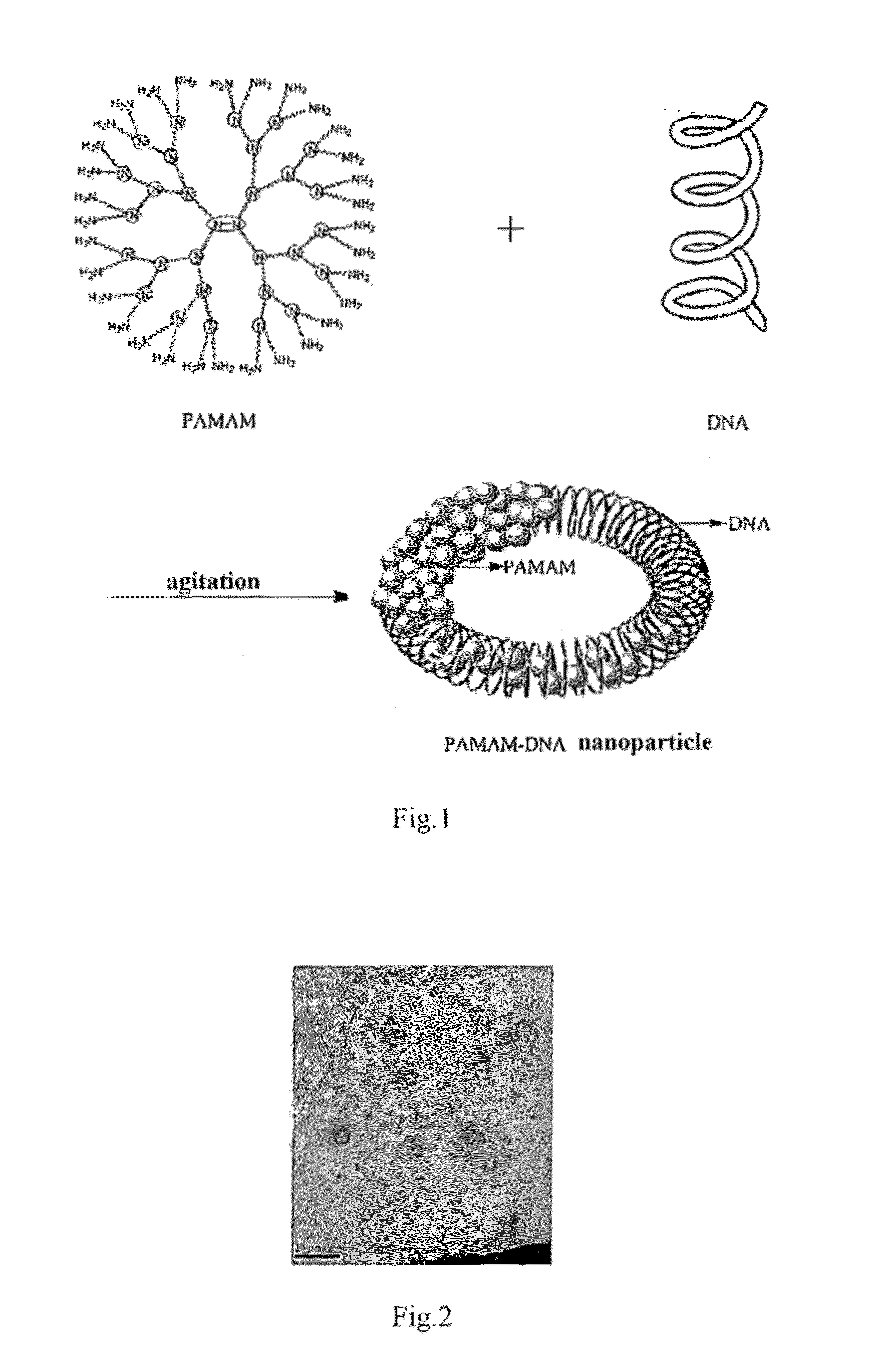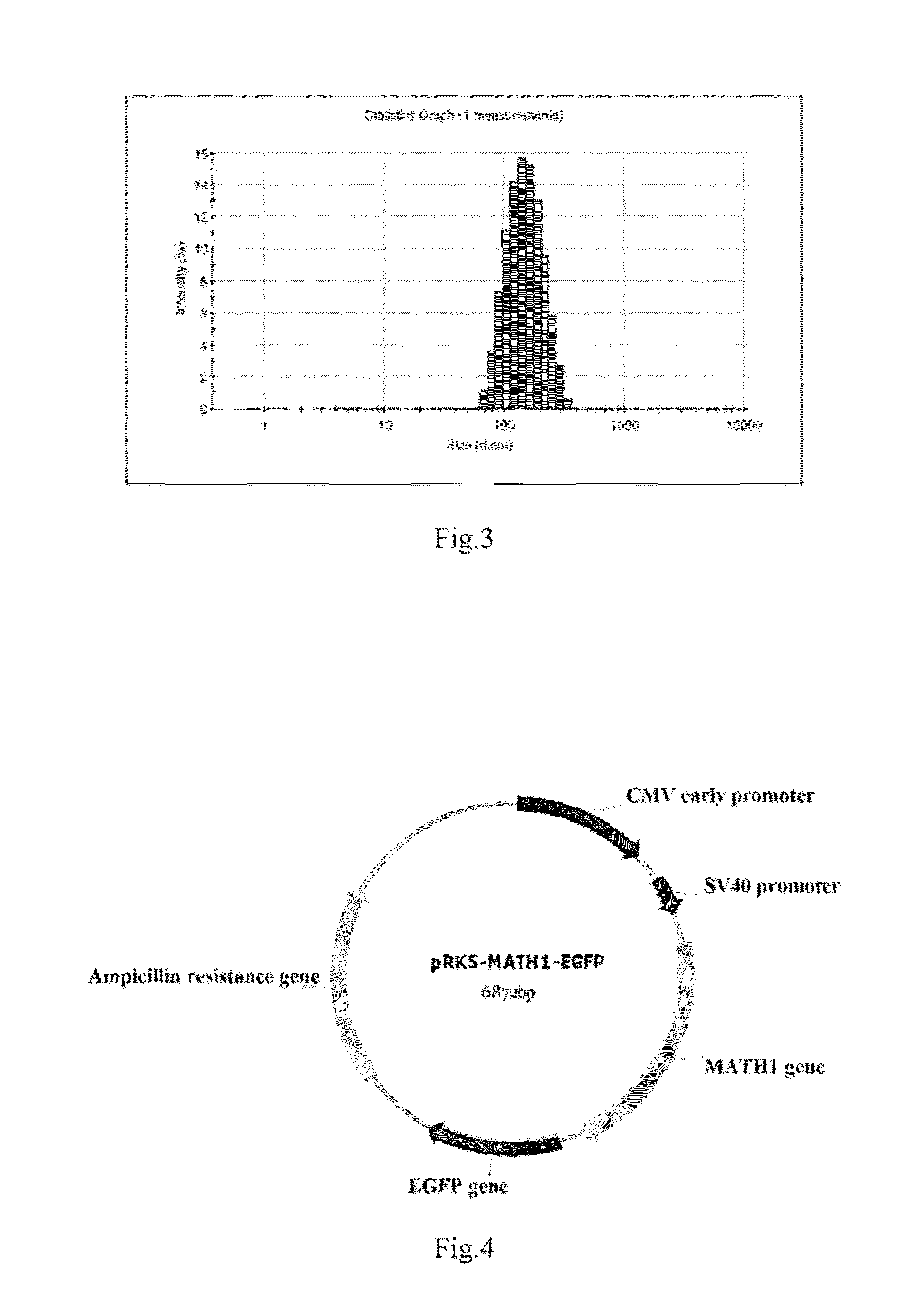Polyamide-amine dendrimer or derivative thereof-math1 gene NANO particle and use thereof in treatment of hearing loss
a technology of polyamideamine dendrimer and nano particles, applied in the field of nano particles for the treatment of hearing loss, can solve the problems of not being restored naturally, not being restored through artificial treatment, and unable to restore hearing and balance, so as to improve the stability of math1 gene, enhance its interaction with cell membranes, and improve transfection efficiency
- Summary
- Abstract
- Description
- Claims
- Application Information
AI Technical Summary
Benefits of technology
Problems solved by technology
Method used
Image
Examples
example 1
Construction of PRK5-Math1 Plasmid
[0051]16-Days brain tissue from embryonic mice was extracted for total RNA by Trizol method, cDNA was synthesized by reverse transcription, Math1 gene containing F-box was synthesized by PCR method, and ECOR1 and BamH1 enzyme restriction cites were added at 5′ and 3′ ends thereof. The PCR amplified product was digested by ECOR1 and BamH1, purified and ligated to a PRK5 plasmid (Clontech) which was also digested by ECOR1 and BamH1, to construct PRK5-Math1 plasmid. Wherein Math1 gene has a sequence shown in FIG. 5.
[0052]Primers for Amplification:
F: 5′-GGAATTAAAATAGTTGGGGGACC-3′;R: 5′-TGGACAGCTTCTTGTTGGCTT-3′.
[0053]Condition for Amplification: 94° C. 5 min; 94° C. 1 min; 58° C. 40 sec; 72° C. 40 sec; 35 cycles, extension at 72° C. 5 min.
example 2
Construction of PRK5-Math1 EGFP Plasmid
[0054]Plasmid pEGFP-C2 (invitrogen) containing EGFP gene and the PRK5-Math1 plasmid of Example 1 were double digested by Hpa1 and XbaI 1 enzyme, respectively, purified and recovered, and ligated by T4 ligase to construct PR K5-Math1-EGFP plasmid.
example 3
Amplification and Purification of PRK5-Math1 EGFP
[0055]100 μl competent E. coli DH 5a bacteria was added to 5 μl PRK5-Math1-EGFP plasmid, homogenized, ice bathed for 30 min, heat shocked at 42° C. for 1 min, ice bathed for 2 min, 800 μl LB medium was added and cultured at 37° C. for 1 hour. 100 μl broth was coated on a plate containing ampicillin and inverted cultured at 37° C. for 16 hours. Single colonies were picked from the plate, inoculated in 5 ml LB liquid medium containing ampicillin, shaken at constant temperature of 37° C. overnight, allowing the bacteria to grow to post-log phase. The plasmid was extracted in accordance with the instruction of plasmid extraction kit (QIAGEN).
[0056]5 U endonuclease (not more than 1 / 10 of the total reaction volume) was added to 0.5˜1 μg plasmid, the reaction volume was 20 μl, bathed for 2 h at proper temperature, and a small amount of samples were taken for agarose gel electrophoresis to detect the digestion result.
PUM
| Property | Measurement | Unit |
|---|---|---|
| zeta potential | aaaaa | aaaaa |
| particle size | aaaaa | aaaaa |
| concentration | aaaaa | aaaaa |
Abstract
Description
Claims
Application Information
 Login to View More
Login to View More - R&D
- Intellectual Property
- Life Sciences
- Materials
- Tech Scout
- Unparalleled Data Quality
- Higher Quality Content
- 60% Fewer Hallucinations
Browse by: Latest US Patents, China's latest patents, Technical Efficacy Thesaurus, Application Domain, Technology Topic, Popular Technical Reports.
© 2025 PatSnap. All rights reserved.Legal|Privacy policy|Modern Slavery Act Transparency Statement|Sitemap|About US| Contact US: help@patsnap.com



